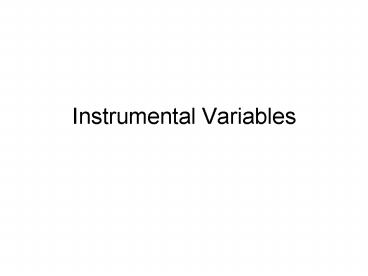Instrumental Variables - PowerPoint PPT Presentation
1 / 16
Title:
Instrumental Variables
Description:
Class exercise. Need to get estimate of s2. Use estimated residual to do this (as in OLS) ... (using (AB)-1=B-1A-1. In one-dimensional case... Can write this as ... – PowerPoint PPT presentation
Number of Views:117
Avg rating:3.0/5.0
Title: Instrumental Variables
1
Instrumental Variables
2
General Use
- For getting a consistent estimate of ß in
- YXße
- when X is correlated with e
- Will see it working with omitted variable bias,
endogeneity, measurement error - Intuition variation in X can be divided into two
bits - Bit correlated with e this causes the problems
- Bit uncorrelated with e
- Want to use the second bit this is what IV does
3
Some Terminology
- Denote set of instruments by Z.
- Dimension of X is (Nxk), dimension of Z is (Nxm).
- If km this is just-identified case
- If kltm this is over-identified case
- If kgtm this is under-identified case (go home)
- Some variables in X may also be in Z these are
the exogenous variables - Variables in X but not in Z are the endogenous
variables - Variables in Z but not in X are the instruments
4
Conditions for a Valid Instrument
- Instrument Relevance
- Cov(Zi,Xi)?0
- Instrument Exogeneity
- Cov(Zi,ei)0
- These conditions ensure that the part of X that
is correlated with Z only contains the good
variation - Instrument relevance is testable
- Instrument exogeneity is not fully testable (can
test over-identifying restrictions) need to
argue plausibility
5
Instrument Relevance and Exogeneity Alternative
Representation
- Instrument Relevance
- Instrument Exogeneity
6
Two-Stage Least Squares the First-Stage
- To get bit of X that is correlated with Z, run
regression of X on Z - XZ?v
- Leads to estimates
7
Two-Stage Least Squares- the Second Stage
- Need to ensure the predicted value of X is of
rank k this is why cant have mltk - Run regression of y on predicted value of X
- IV (2SLS) estimate of ß is
8
Use formula for X-hat
9
Proof of Consistency of IV Estimator
- Substitute yXße to give
- Take plims
- Second term is zero when can invert first inverse
- Can do this when instrument relevance satisfied
- Note IV estimator is not unbiased, just
consistent - Estimate should be independent of instrument used
10
The Asymptotic Variance of the IV estimator
- Class exercise
- Need to get estimate of s2
- Use estimated residual to do this (as in OLS)
- To estimate residual must use X not X-hat i.e.
11
Implication
- Never do 2SLS in two stages standard errors in
second stage will be wrong as STATA will compute
residuals as
- Easier to do it in one line if x1 endogenous, x2
exogenous, z instruments - . reg y x1 x2 (x2 z)
- . ivreg y x2 (x1z)
12
The Finite Sample Distribution
- Results on IV estimator are asymptotic
- Small sample distribution may be very different
- Especially when instruments are weak not much
correlation between X and Z - Instruments should not be weak in experimental
context - Will return to it later
13
Testing Over-Identification
- If mgtk then over-identified and can test
instrument validity for (m-k) instruments - Basic idea is
- If instruments valid then E(eZ)0 so Z should
not matter when X-hat included - Can test this but not for all Zs as X-hat a
linear combination of Zs
14
Some Special Cases The Just-Identified Case
- In this case (ZX) is invertible
- Can write IV estimator as
(using (AB)-1B-1A-1
15
In one-dimensional case
- Can write this as
- i.e. ratio of coefficient on Z in regression of y
on Z to coefficient on Z in regression of X on Z
16
Binary Instrument No other covariates
- Where Instrument is binary should recognise the
previous as sample equivalent to
- This is called the Wald estimator
- Simple intuition take effect of Z on y and
divide by effect of Z on X































